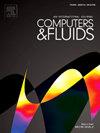Predictive dynamic wetting, fluid–structure interaction simulations for braze run-out
IF 2.5
3区 工程技术
Q3 COMPUTER SCIENCE, INTERDISCIPLINARY APPLICATIONS
引用次数: 0
Abstract
Brazing and soldering are metallurgical joining techniques that use a wetting molten metal to create a joint between two faying surfaces. The quality of the brazing process depends strongly on the wetting properties of the molten filler metal, namely the surface tension and contact angle, and the resulting joint can be susceptible to various defects, such as run-out and underfill, if the material properties or joining conditions are not suitable. In this work, we implement a finite element simulation to predict the formation of such defects in braze processes. This model incorporates both fluid–structure interaction through an arbitrary Eulerian–Lagrangian technique and free surface wetting through conformal decomposition finite element modeling. Upon validating our numerical simulations against experimental run-out studies on a silver-Kovar system, we then use the model to predict run-out and underfill in systems with variable surface tension, contact angles, and applied pressure. Finally, we consider variable joint/surface geometries and show how different geometrical configurations can help to mitigate run-out. This work aims to understand how brazing defects arise and validate a coupled wetting and fluid–structure interaction simulation that can be used for other industrial problems.
预测动态润湿,流体-结构相互作用模拟钎焊运行
钎焊和焊接是冶金连接技术,使用湿润的熔融金属在两个焊接表面之间创建连接。钎焊工艺的质量在很大程度上取决于熔融填充金属的润湿性能,即表面张力和接触角,如果材料性能或连接条件不合适,由此产生的接头可能容易出现各种缺陷,如跳动和欠填充。在这项工作中,我们实现了一个有限元模拟来预测在钎焊过程中这种缺陷的形成。该模型结合了任意欧拉-拉格朗日技术的流固相互作用和保形分解有限元建模的自由表面润湿。在验证了我们的数值模拟与银- kovar系统的实验运行研究之后,我们使用该模型来预测具有可变表面张力、接触角和施加压力的系统的运行和下填。最后,我们考虑了可变的关节/表面几何形状,并展示了不同的几何结构如何有助于减少磨损。这项工作旨在了解钎焊缺陷是如何产生的,并验证可用于其他工业问题的耦合润湿和流固耦合模拟。
本文章由计算机程序翻译,如有差异,请以英文原文为准。
求助全文
约1分钟内获得全文
求助全文
来源期刊

Computers & Fluids
物理-计算机:跨学科应用
CiteScore
5.30
自引率
7.10%
发文量
242
审稿时长
10.8 months
期刊介绍:
Computers & Fluids is multidisciplinary. The term ''fluid'' is interpreted in the broadest sense. Hydro- and aerodynamics, high-speed and physical gas dynamics, turbulence and flow stability, multiphase flow, rheology, tribology and fluid-structure interaction are all of interest, provided that computer technique plays a significant role in the associated studies or design methodology.
 求助内容:
求助内容: 应助结果提醒方式:
应助结果提醒方式:


